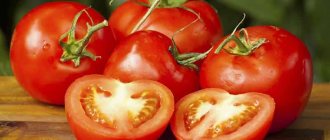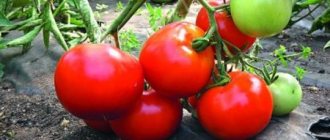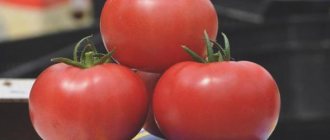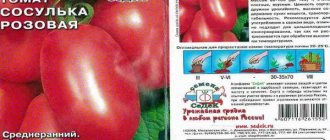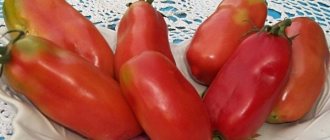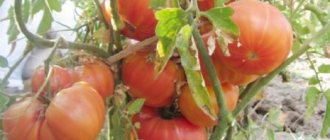The Polar early ripening tomato will appeal to summer residents of cold regions, where tomatoes are traditionally planted in greenhouses. It can grow in open ground, bears fruit well, and its classic tomato taste will complement any vegetable dish.
| Height | Landing location | Ripening time | Fruit color | Fruit size | Origin | Fruit shape |
| short | Greenhouse, Open ground | Ultra early | Reds | Average | Variety | Round |
Description and characteristics of the variety
Polar early ripening tomato bushes of determinate type, with an average height of 40 cm, a maximum of 70 cm. The first inflorescence develops above the 7th leaf, and the interval between the next ones is two leaves each. The variety is considered ultra-early, the first harvest is harvested 99-105 days after planting. The fruits are round or flat-round, resembling apples. Their color at maturity is red, the average size is 60-100 g, but with careful care and feeding you can get tomatoes weighing 150-160 g. Inside there are 7-12 seed chambers and about 7% dry matter.
The taste is ordinary tomato, has a sourness. The use is universal: you can preserve and pickle fruits, cook dishes and eat them fresh.
How to get a good harvest
The quantity and quality of the future harvest, as well as susceptibility to diseases and pests, depend on compliance with the rules of agricultural technology. The latter often affect weak plants. Gardeners use various techniques to ensure good growth, development and smooth ripening of fruits. With proper care, there will be no pests on the tomato.
See also
Characteristics and description of the tomato variety King of Kings, its yieldRead
First you need to buy quality seeds. The packaging must be sealed, with a specified expiration date, the seeds must be smooth, of characteristic size and color. Lightweight and puny seeds do not produce a good harvest. After opening the bag, you need to pay attention to the presence of an unpleasant odor. If it is, the planting material is not suitable.
High-quality seeds are hardened at a temperature of 0 °C. To do this, they are placed outside or in the refrigerator, where they are kept for 15 hours. This procedure stimulates the processes inside the seeds, as a result they germinate faster. The fruits ripen on average 10-14 days earlier. Caring for seedlings is common, but there is one peculiarity: you should not neglect feeding and skimp on growth stimulants. Early ripening varieties should receive everything they need at a very early stage, then in the future they will not lag behind in development.
Seedling method
Seedlings allow you to delay the harvest time by 5-10 days. First, the seeds are sown in containers, then planted, and when warm weather arrives, they are planted in the ground.
What is a Polar early ripening tomato?
Characteristics and description of the variety:
- early ripening: if you follow the description on the packaging, you can conclude that the time period from release to the first harvest is about 3.5 months;
- determinate - the bushes are compact in size and have a small number of leaves (the stem usually does not grow higher than 40 cm);
- The first inflorescences are formed near the 7th leaf, the rest - after a couple of leaves.
Among the key advantages of the variety are the following:
- unpretentiousness - the variety does not require special care or temperature control;
- good and stable yield even in dry periods;
- stable fruit formation.
If a tomato is well and properly cared for, it can bear fruit weighing up to 160 g. The fruit itself has a fleshy consistency. Shaped like an apple. The fruits have a sweet taste, well balanced with sourness. Picked tomatoes can ripen in a warm, dark place. Green tomatoes of the Polar variety can be stored for about a month, ripe ones - up to 3 weeks.
Tomatoes can be used universally in cooking. It is eaten fresh and used in making pickles. In addition, Polar is used in the production of sauces, tomato paste, purees and other culinary products of this type.
Reviews from summer residents about the variety
- Yulia Savina, 34 years old:
I planted Polar early ripening too. Strong little bushes have grown. I liked that you can grow them completely without supports or garters. The variety quickly and unanimously gave away the entire harvest. The tomatoes, although not large, are beautiful and tasty. And they ate and prepared for future use. In my conditions it performed well, and this is already a big plus for Siberians. - Alexander Evstafiev, 40 years old:
I decided to try the classics and trust our zoned variety. And I didn’t regret it. The tomatoes felt good in the greenhouse and began to bear fruit very early. Of the obvious advantages, I noted that this variety requires minimal care. There is no need to spend a lot of time and effort on constantly removing stepsons, eternal garters, and trimmings. In general, I'm happy!
Puzatiki tomato - description and characteristics of the variety
Strengths of the variety
- Stable fruiting in a number of unfavorable weather conditions, during dry or, on the contrary, rainy periods.
- Liberalism in agricultural technology and unpretentiousness in growing conditions.
- They can withstand short periods of cold weather.
- The ability to set fruit in stressful situations.
- Good yield throughout the season, 4-5 kg per 1 kg/sq.m.
- Along with competent agricultural technology and in protected soil conditions, Polar early ripening is able to almost double the yield indicators - up to 7-8 kg/sq.m.
- High fertility when grown both by seedlings and without seedlings.
- The first fruit inflorescence is formed after the growth of 7 leaves, subsequent clusters every 2.
- Excellent shelf life and transportability, suitable for transportation over long distances.
- The fruits have a good tendency to ripen. Tomatoes picked while still green can be kept for up to a month under suitable conditions.
- Resistance to diseases, in particular to the tobacco mosaic virus, and in turn brown spot.
Secrets of successful cultivation of the variety
- To maintain high yields and to avoid thickening of the bush, the removal of stepsons is required.
- For cultivation in the southern regions, it is desirable to place them in the shade and away from taller and leafier tomatoes. Under the direct rays of the scorching sun, the tomato will quickly begin to age.
- Before planting, it is advisable for the seeds to undergo stratification at a temperature of 0 -2C degrees. It consists of placing the seeds in the refrigerator or taking them outside, where they are hardened during the day.
- When planting without seedlings, it is strongly recommended to grow tomatoes under a covering material (agrofibre, spunbond, lutrasil). You can remove the cover when the threat of frost has passed and the plants have become stronger.
- Scheme: planting 35x50 cm, number of plants 6-9 pcs. per sq. meter.
- Despite the resistance of tomatoes to various negative factors, it is advisable to carry out 1-2 preventive treatments against diseases and pests.
- Adding organic matter to the soil and regularly providing macro- and microelements in the quantities required for tomatoes.
Despite all the advantages, the variety, unfortunately, is inferior to new hybrids in many respects.
Ultra early ripening tomato varieties
Every gardener wants to get a tomato harvest that is not only high-quality and high, but also early. Ultra-early tomato varieties, which are available in a wide variety, will help him with this. With proper care and compliance with all agrotechnical rules, after 3 months you can enjoy fresh, juicy and tasty fruits.
Characteristics and description
Ultra-early tomato differs from other types in terms of ripening time. Ultra-early ripening varieties of tomatoes produce a harvest within 90 days after germination, tomatoes with medium ripeness - after 115 days, and late varieties - after 130 days. But ultra-early ripening ones will allow you to enjoy fresh vegetables after 80 days.
Early ripening tomatoes have many advantages, including:
- High and high-quality harvest in a short time.
- Ultra-early ripening varieties are much hardier, so they can be grown in Siberia and the Urals.
- There are varieties designed for growing in greenhouses and open ground.
- Tomatoes are not susceptible to late blight. The reason is that they mature faster than the period of defeat by this disease.
Early ripening tomato varieties
Let's consider the popular ultra-early ripening tomatoes for the greenhouse. The list below is perhaps the fastest ripening varieties of tomatoes.
Alaska
This type of tomato can grow up to 70 cm. Each vegetable weighs 90 g. The yield is average - 1 m2 yields 7 kg. The main advantage of Alaska remains the formation of ovaries in any weather conditions. In addition, the bushes do not need to be tied up during the growing process, since they have strong stems.
Far North
This is a determinate hybrid variety. The height of the bushes is 65 cm, but they do not need a garter. Caring for a vegetable crop is simple; you just need to moderately moisten the soil and apply fertilizer 2 times a season.
The variety does not take steps, and the fruits grow and develop well even in unfavorable climate conditions. The plant is grown without seedlings. You can enjoy ripe vegetables within 85-95 days from the moment of sprouting. The variety is suitable for growing in open ground and in a greenhouse. One fruit weighs 80 g. From one bush you can harvest 1.5 kg of tomatoes.
F1 doll
It is also a determinate hybrid, with a ripening period of 3 months. Bushes grow up to 70 cm. Needs pinching. One fruit weighs 150 g and is used for fresh consumption.
Maksimka
This ultra-early ripening greenhouse tomato produces a harvest in 83 days. Plant height 50 cm, semi-spreading bushes. If you grow Maximka in difficult climatic conditions, then it needs film cover.
Snowdrop
A standard semi-determinate variety that produces ripe tomatoes in 80 days. The height of the bush is 130 cm, and the weight of the fruit is 120 g. It is often cultivated using the seedless method. Plant seedlings in open ground or in a film cover in April.
Snowdrop places demands on the composition of the soil. During the growing process, fertilize on time. If you follow all agrotechnical rules, you will be able to collect 6 kg of ripe and tasty fruits from one bush.
Amur standard
An ultra-early ripening type of tomato, when grown, harvesting occurs on the 90th day after planting. The height of the bush is 50 cm, the weight of the tomato is 80 g. The advantage of the hybrid is that it is undemanding in terms of care. The Amur standard is perfect for the northern regions.
Alpha
A standard ultra-early ripening variety that produces a harvest on the 87th day. The plant quickly gets used to the climate, even if it is planted using the seedless method. The height of the bush is 50 cm, the fruits are small, but incredibly juicy.
Ultra early ripening
Ripening occurs on the 70th day. Standard bushes grow up to 60 cm. The advantage of the variety is good immunity to late blight and other common diseases. Ultra-early ripening - high-yielding, 15 kg of fruit can be obtained from 1 m2. One weighs approximately 100 g.
Volgogradsky
This variety is very popular among summer residents who do not have the opportunity to constantly monitor their plantings. The variety is determinate, its bushes are low and do not require additional staking. Such plants grow well without special care. Fruiting occurs after 105 days.
The main advantage of the Volgograd tomato remains its high yield. 10 fruits ripen on one cluster. They are round and slightly flattened. One Volgograd early ripening tomato weighs 100 g. The variety is able to resist common diseases. The harvested crop is suitable for consumption fresh or canned.
Polar
The variety is early ripening and belongs to the ultra-early variety. You can enjoy the harvest within 99-105 days after planting. From 1 m2 it turns out 4-5 kg. But if you carefully care for it and regularly fertilize it, the yield will increase to 7-8 kg.
When growing the Polar tomato, it forms standard determinate bushes. They are distinguished by their compact size and weak foliage. The height of the plant is 30-40 cm. If you properly care for the bushes, the weight of the fruits at the time of harvest will be 160 g. They have a fleshy consistency, and their shape resembles an apple. Sweet, there is a slight sourness and a pronounced tomato aftertaste.
Skorospelka
A spreading bush, the height of which reaches 70 cm, so you can refuse a garter. The tomato variety Pink early ripening received this name not by chance, because ripe fruits can be collected 87-95 days after the formation of shoots. The fruits are flat-round in shape and weigh 150 g.
The taste is good - sweet with a high concentration of biologically active substances. Collected vegetables can be used to prepare early salads and for processing. From 1 m2 it is possible to collect 5-7 kg of ripe tomatoes.
Growing and caring for early ripening varieties
The process of growing early ripening tomatoes is simple. You can use the seedling or seed method for this.
Growing seedlings
The process of sowing seeds is carried out as follows:
- Send the planting material into a container with fertilized substrate in March.
- Sow seeds to a depth of 2-3 cm.
- To keep the soil temperature constant, cover the container with glass.
- As soon as 2 true leaves are formed, pick. During this process, plant the plants in separate pots or in a greenhouse.
- Planting seedlings in open ground occurs only after the likelihood of frost returning has disappeared.
Planting in open ground
Before sending seedlings into open ground, harden them. 10 days before planting, place the seedlings on the balcony for 5-10 minutes, increasing the time interval by 5 minutes every day.
- Plant plants in holes or trenches. Maintain a distance of 40 cm between bushes.
- It is better to plant tomatoes in a well-lit place where there is no direct sunlight.
- Choose light and fertile soil.
After planting, plants need regular moisture. For irrigation, use only warm and settled water. It is best to irrigate in the evening. Feed plants with potassium fertilizers. Apply them once every 2 weeks after watering.
You can prevent contamination of tomatoes and make harvesting easier by tying up the bushes. Pinching will allow the plant to direct all its forces to the development of fruits, and not the growth of stems.
To better understand what ultra-early ripening tomato varieties for greenhouses look like, you can look at the photographs below.
You can also watch this video, where an experienced gardener will tell you about the Ultra-early variety.
Ultra-early ripening varieties of tomatoes for greenhouses are a frequent choice of gardeners. Their main advantages: high and early yield, strong immunity to diseases and ease of care. And the sweet taste and pleasant aroma of such tomatoes will only add to their popularity.
Fertilizer application
Before the ovary appears, it is recommended to fertilize with nitrogen. Nitrogen-based preparations promote the growth of green mass and accelerate the growth of bushes. Subsequent fertilizing should be done with potassium fertilizers, which help increase productivity. It is better to use homemade infusions of ash or potassium sulfate.
You should not use potassium chloride, the active components inhibit the bushes and reduce fruiting.
At the time of flowering, give preference to boron-based preparations. The lack of this element will cause the ovary to fall off. It is better to treat the leaves with nutritional compounds, this helps the tomatoes absorb the necessary substances.
The easiest way to add the necessary elements to the soil is to use nutritious mulch. Rotted manure and compost spread around the tomatoes will protect the soil from drying out and decreasing temperature. Rainwater will allow beneficial elements to penetrate to the roots of the bushes.
How to water Siberian early ripening?
It is important not to overdo it when watering the variety - tomatoes are easily affected by diseases at high humidity. It is recommended to moisten the soil every 2-3 days, but only under stable heat.
Use only warm water for watering tomatoes, pre-infused in the sun. For one bush, 6-8 liters of liquid is enough. For better penetration of moisture into the soil, loosen the soil first. Do not penetrate too deep into the soil; there is a risk of damaging the roots, which will affect the above-ground part of the bush.

